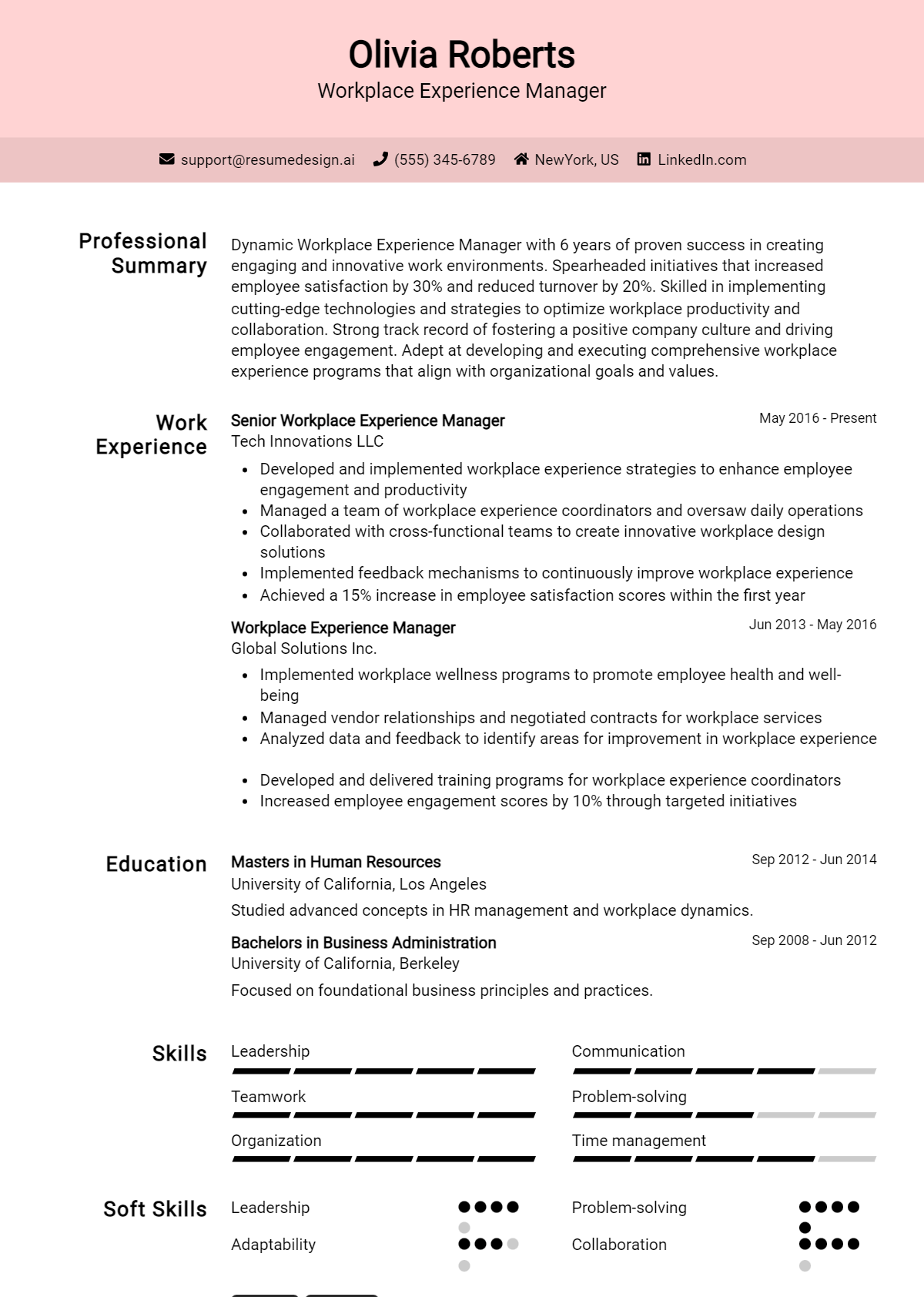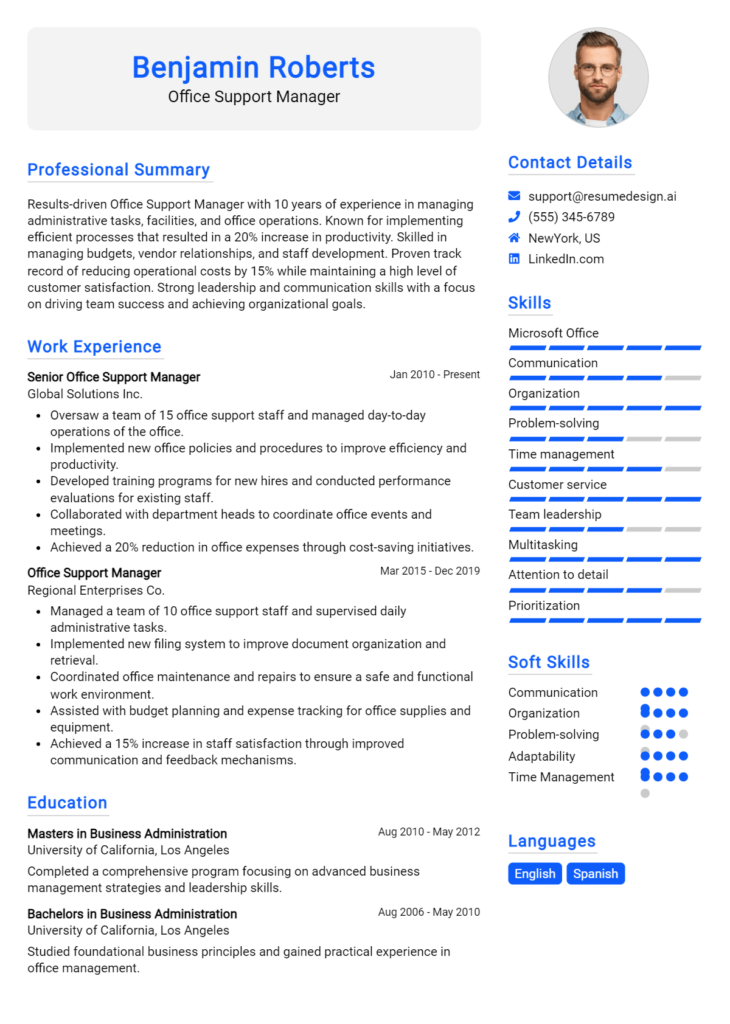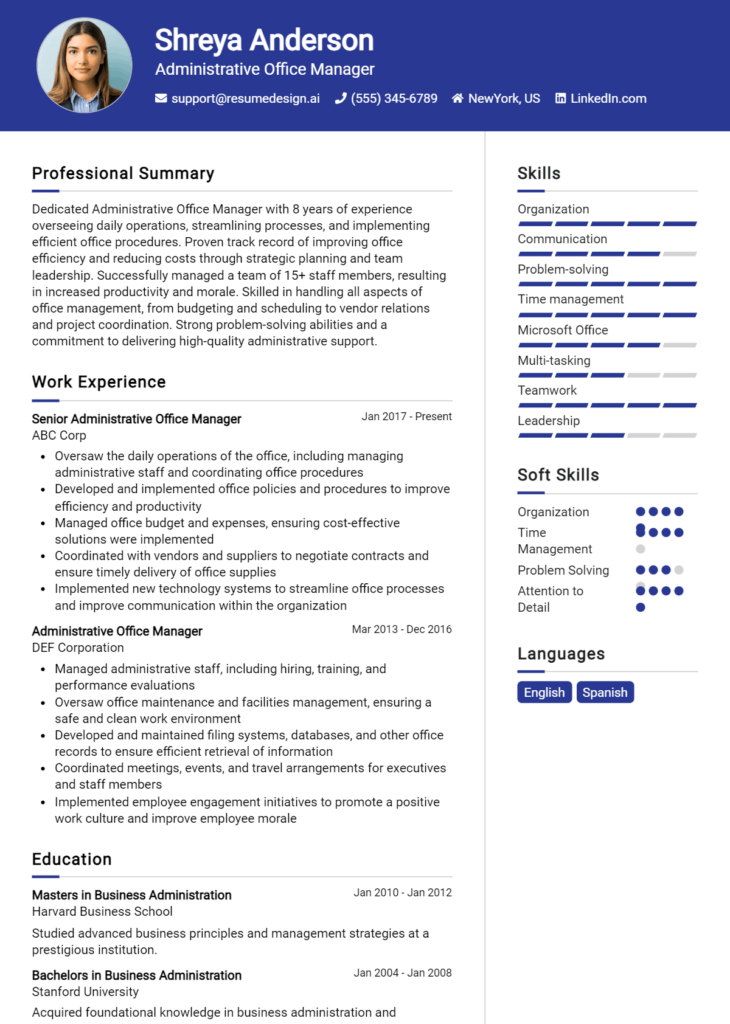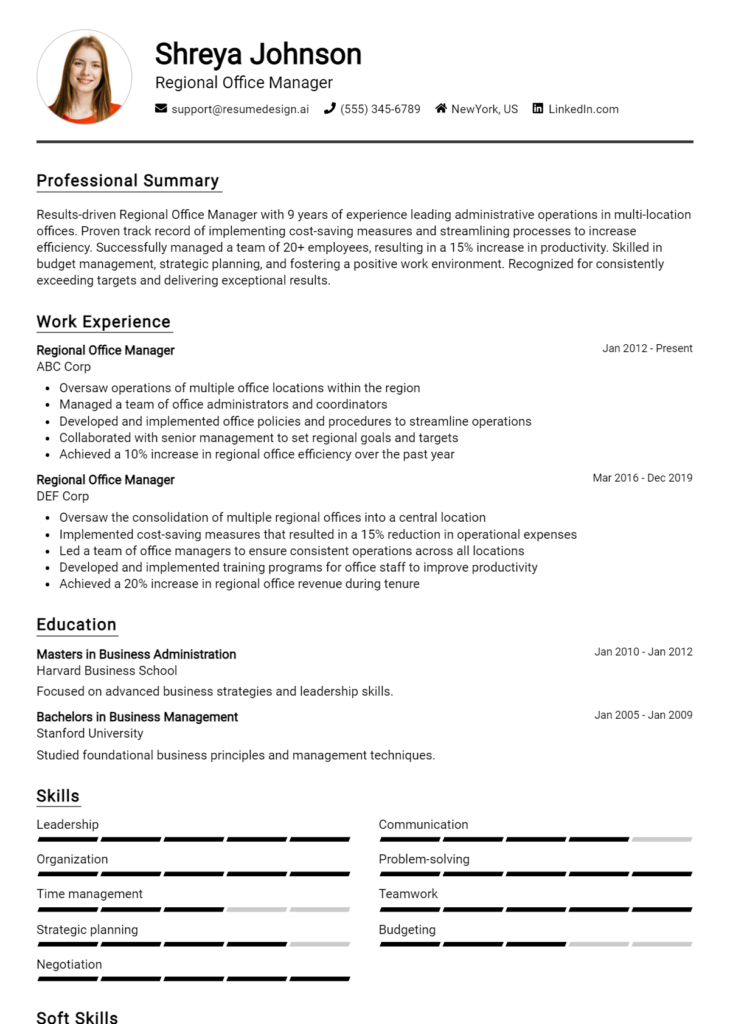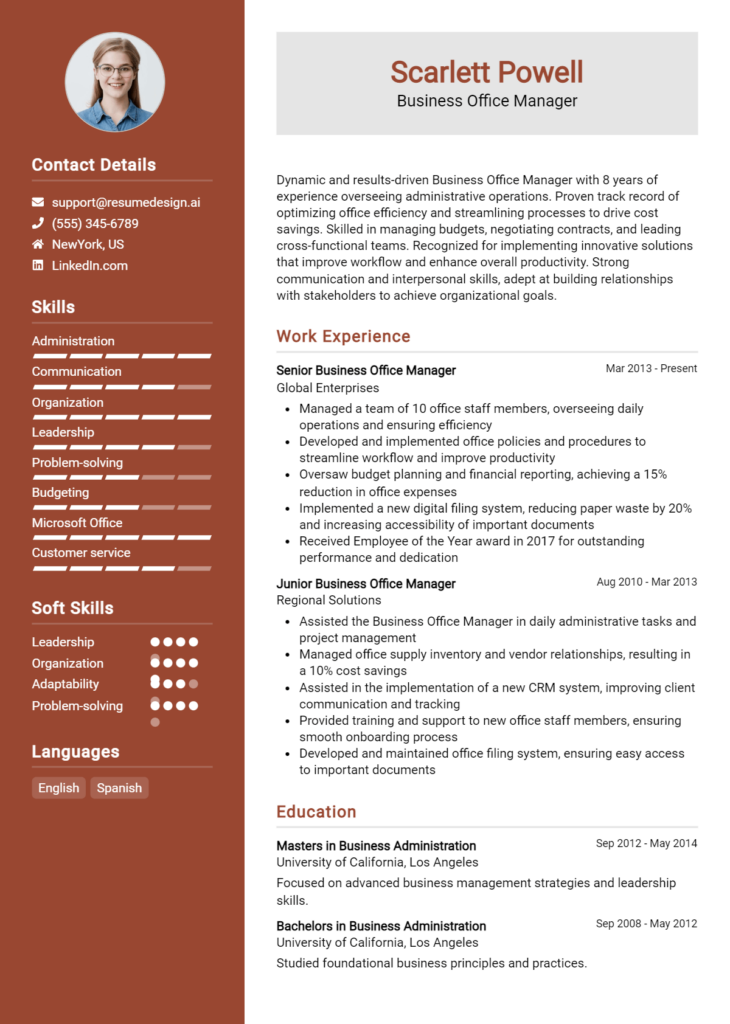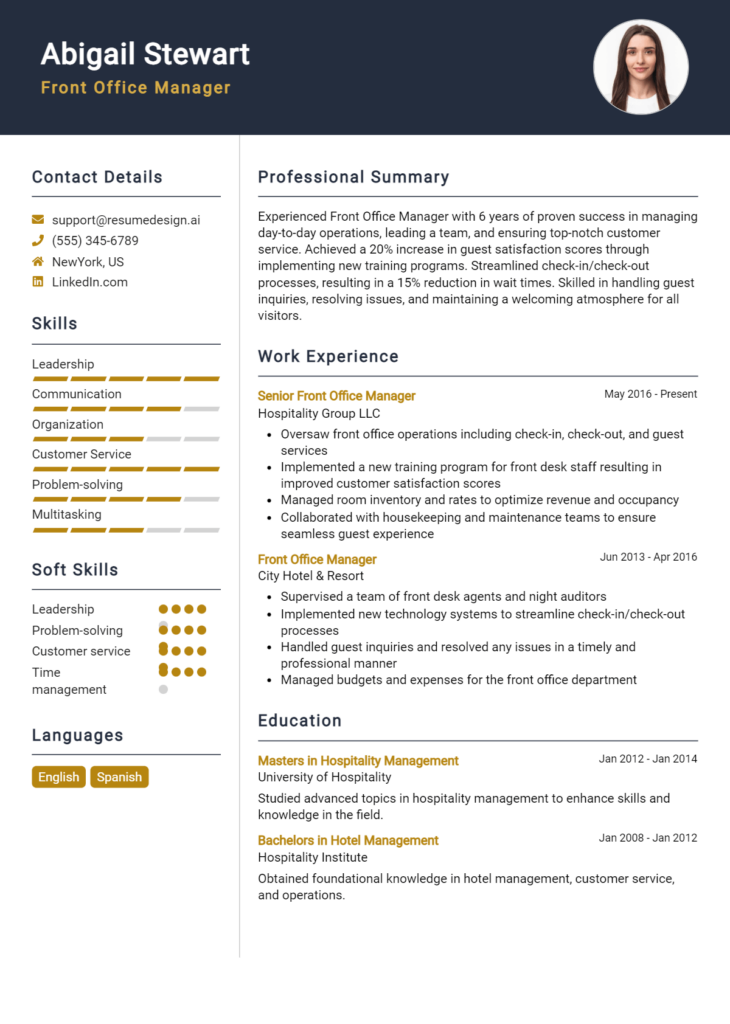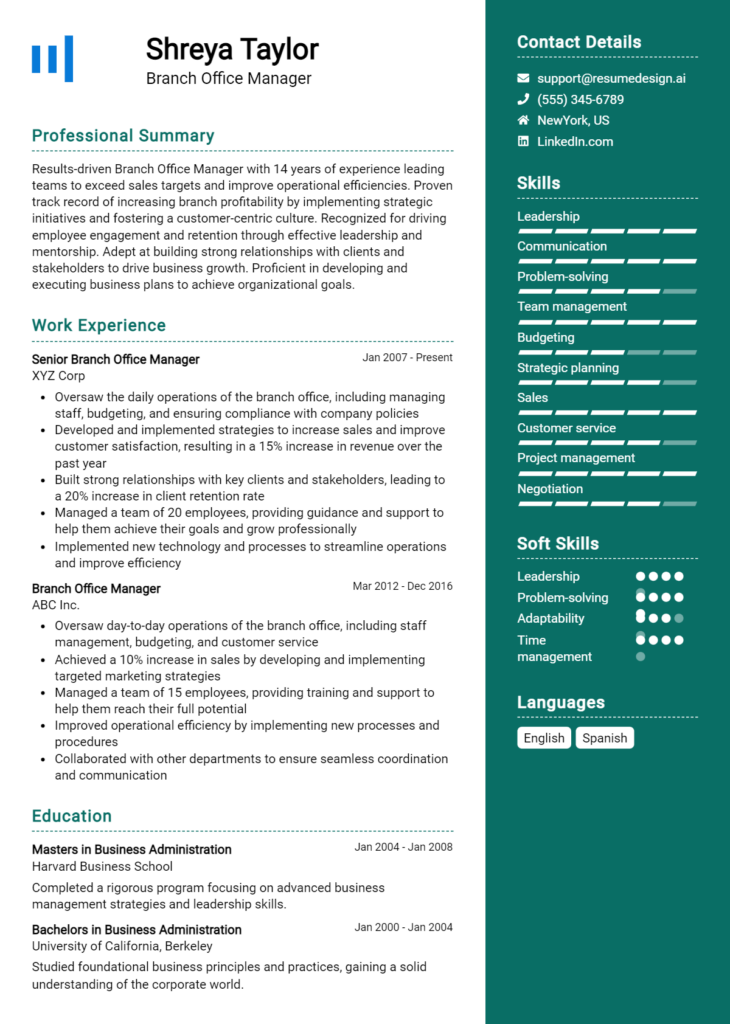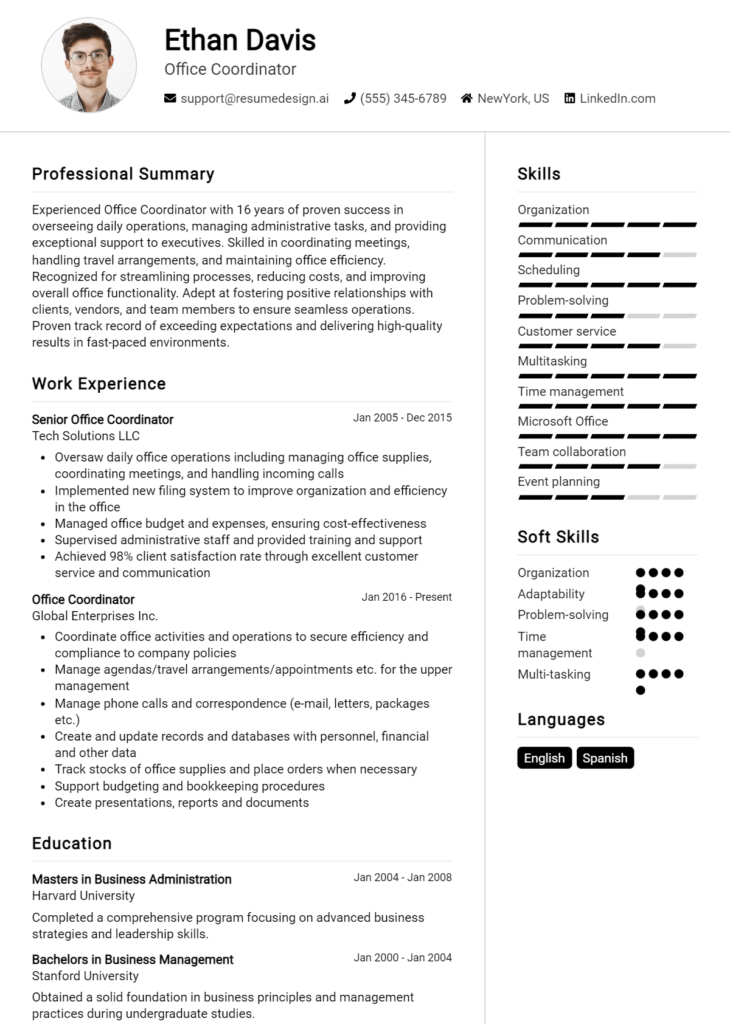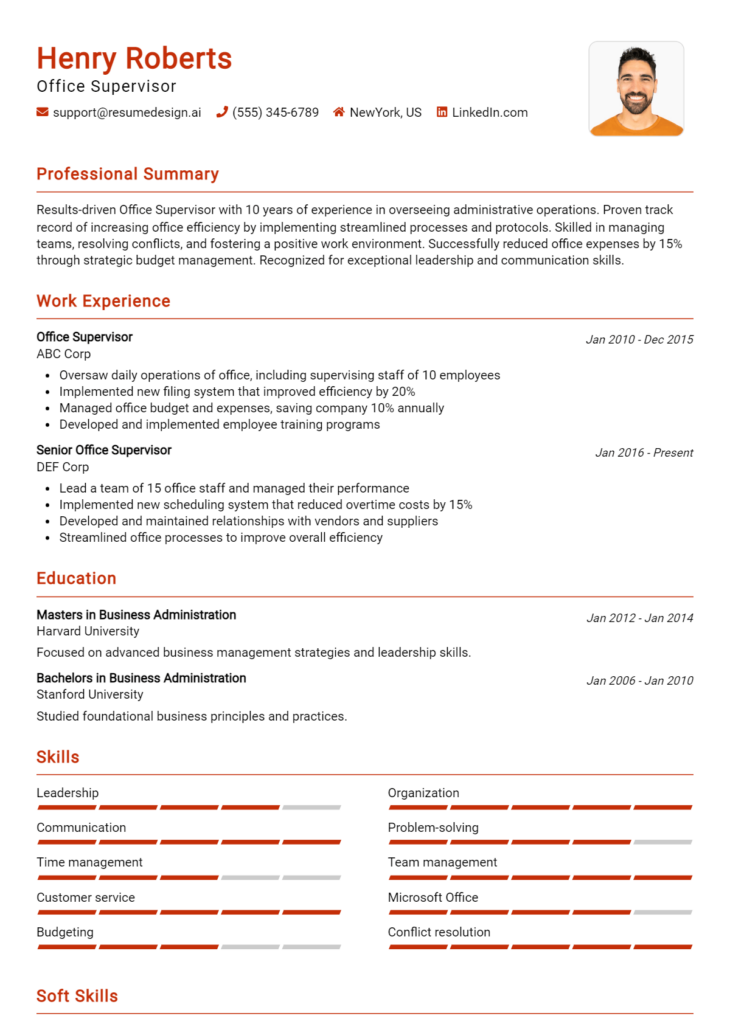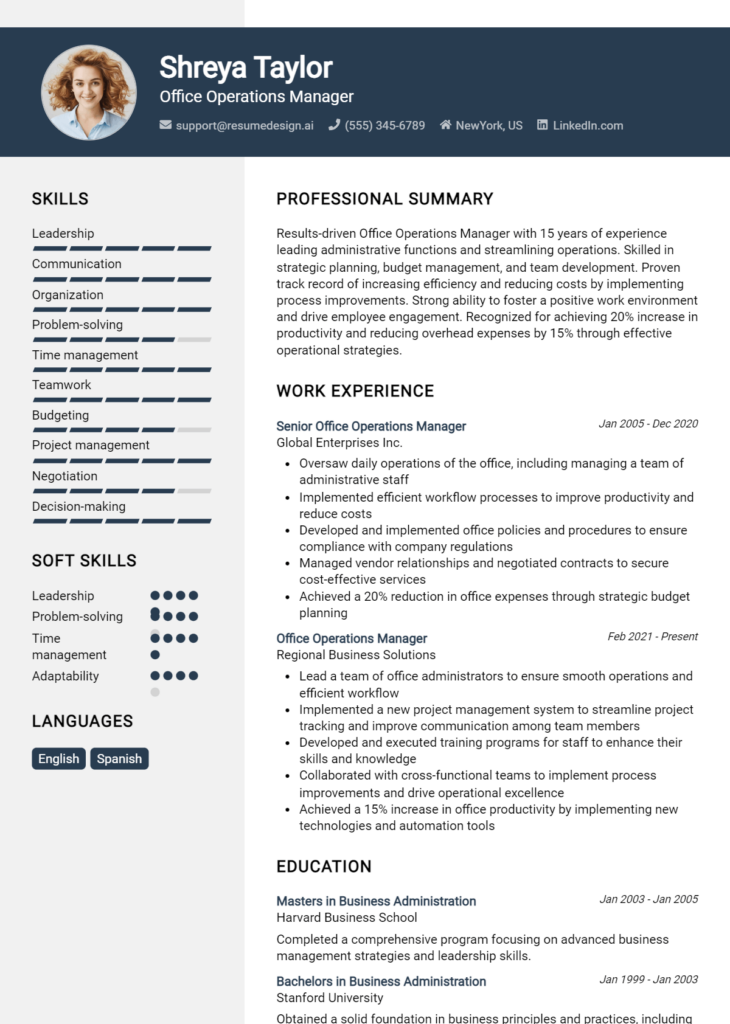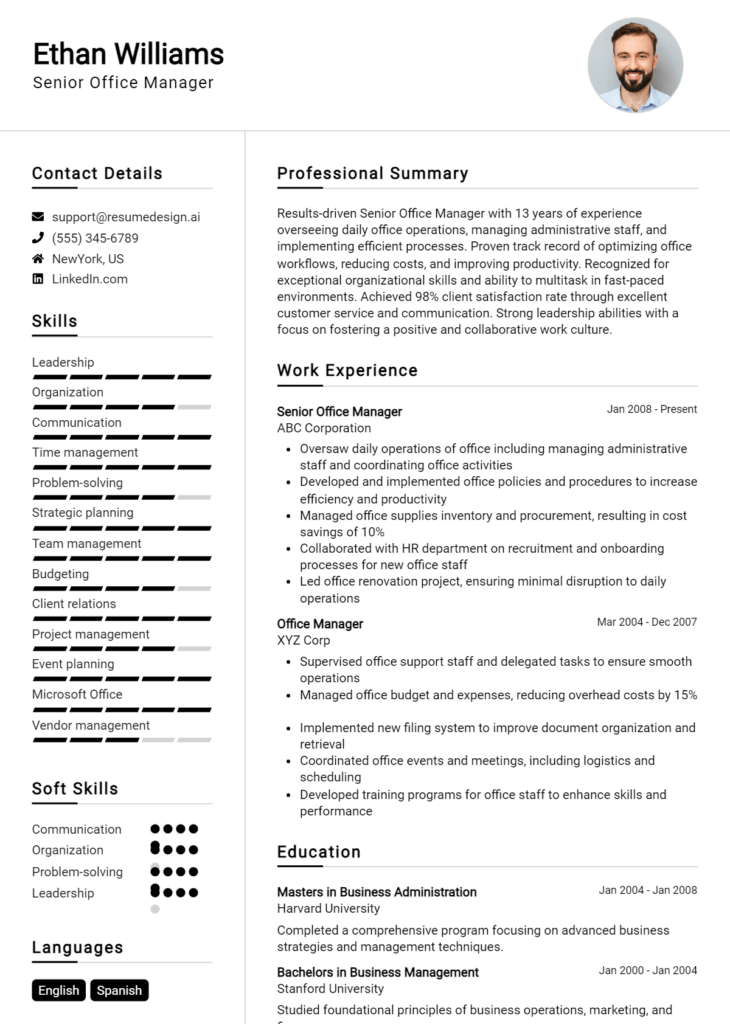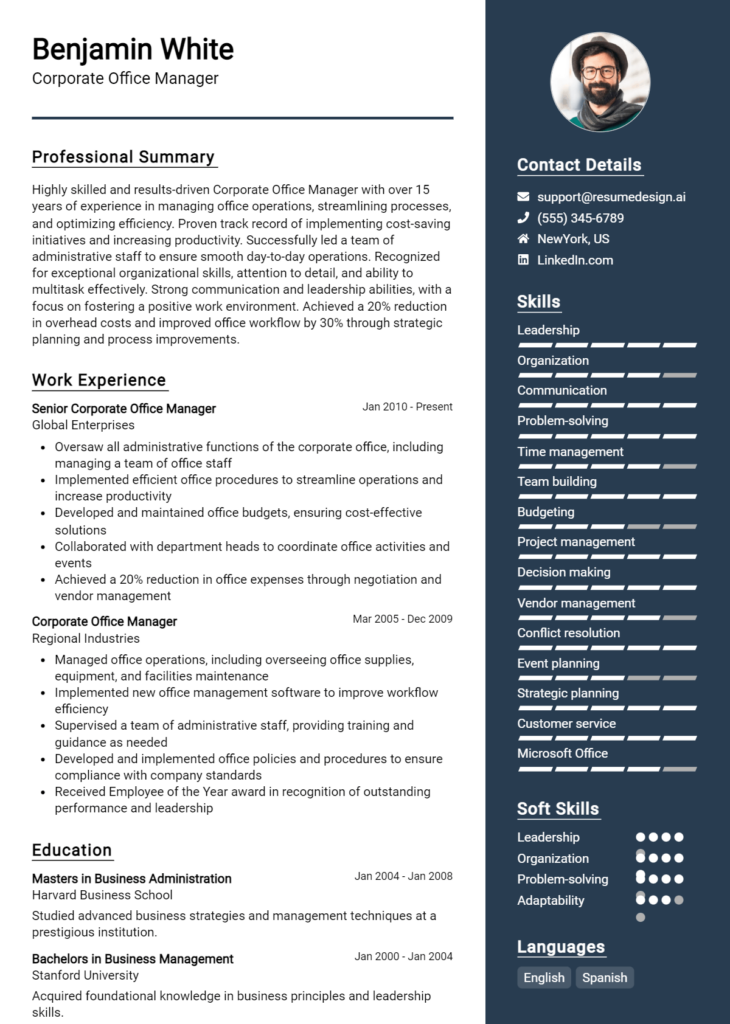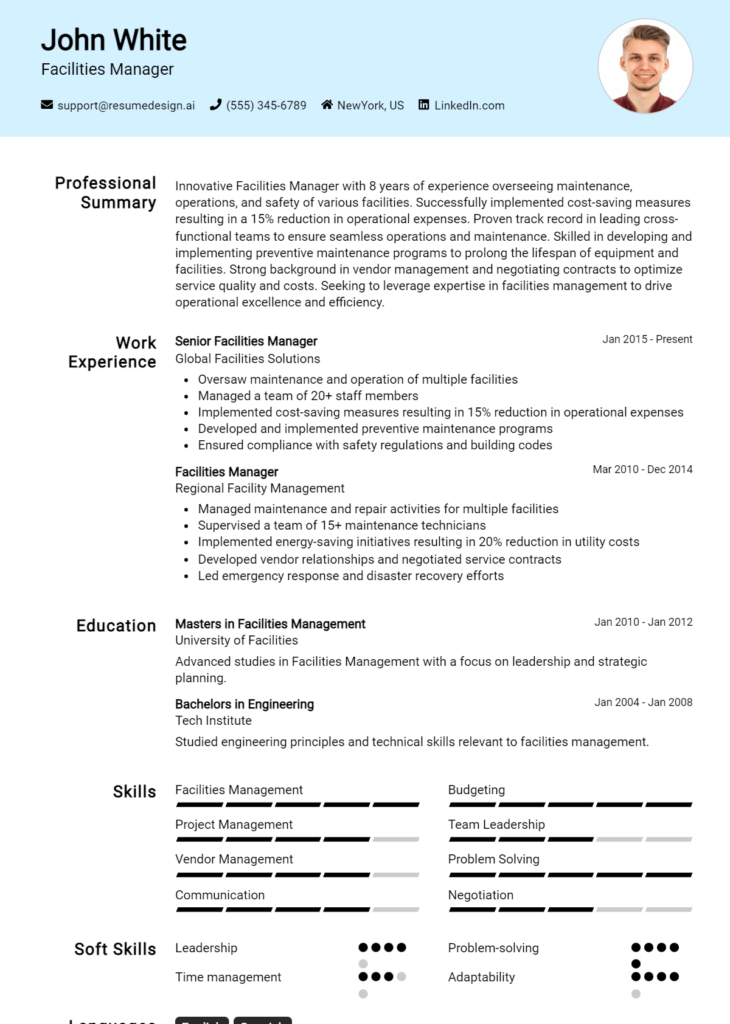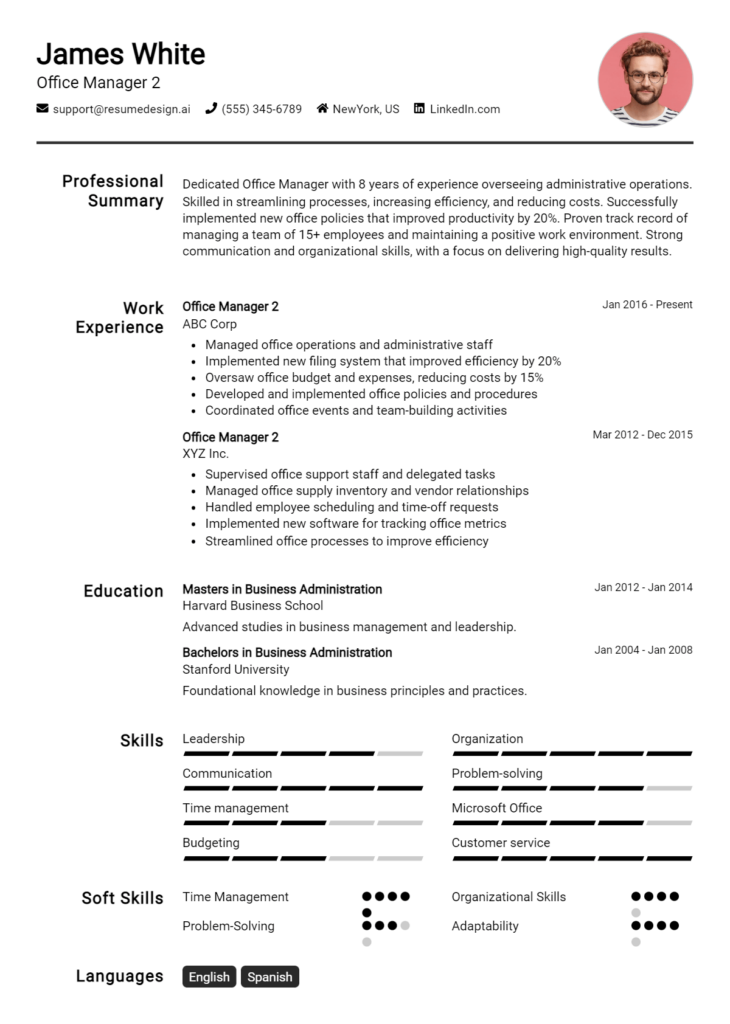Workplace Experience Manager Core Responsibilities
A Workplace Experience Manager plays a pivotal role in enhancing employee satisfaction and operational efficiency by bridging various departments such as HR, facilities, and IT. This professional must possess strong technical, operational, and problem-solving skills to create a seamless workplace environment. Their expertise contributes to achieving organizational goals by fostering collaboration and innovation. A well-structured resume that highlights these qualifications is essential for showcasing their ability to drive workplace excellence and enhance overall employee engagement.
Common Responsibilities Listed on Workplace Experience Manager Resume
- Develop and implement workplace experience strategies to enhance employee satisfaction.
- Collaborate with HR to design programs that promote a positive company culture.
- Manage workplace facilities and ensure safety compliance.
- Oversee office layout and design projects to improve functionality.
- Facilitate communication between departments to address workplace issues.
- Analyze employee feedback to identify areas for improvement.
- Coordinate events and activities that foster team collaboration.
- Implement technology solutions to streamline workplace operations.
- Monitor budget and resources for workplace improvements.
- Develop training programs focused on workplace best practices.
High-Level Resume Tips for Workplace Experience Manager Professionals
In today’s competitive job market, a well-crafted resume is crucial for Workplace Experience Manager professionals aiming to make a lasting impression on potential employers. Your resume is often the first point of contact between you and your future employer, serving as a showcase of your skills, achievements, and professional journey. It needs to clearly articulate your ability to enhance workplace culture, streamline operations, and boost employee satisfaction. This guide will provide practical and actionable resume tips specifically tailored for Workplace Experience Manager professionals, ensuring you stand out in a sea of applicants.
Top Resume Tips for Workplace Experience Manager Professionals
- Tailor your resume to match the specific job description, using keywords and phrases from the listing to demonstrate alignment with the role.
- Highlight relevant experience by focusing on previous roles that involved employee engagement, facility management, or organizational development.
- Quantify your achievements with metrics, such as percentage increases in employee satisfaction or reductions in turnover rates, to showcase your impact.
- Include industry-specific skills, such as knowledge of workplace design principles or familiarity with employee wellness programs, to enhance your expertise.
- Utilize a clean, professional layout that emphasizes readability and makes key information easily accessible to hiring managers.
- Incorporate a strong summary statement at the top of your resume that encapsulates your career goals and key qualifications.
- Showcase your soft skills, such as communication, leadership, and problem-solving, which are vital for a Workplace Experience Manager.
- List relevant certifications or training, such as in HR management or workplace safety, to demonstrate your commitment to the profession.
- Keep your resume concise, ideally one page, focusing on the most pertinent information that highlights your qualifications.
Implementing these tips can significantly increase your chances of landing a job in the Workplace Experience Manager field. By presenting a well-structured and targeted resume, you not only highlight your qualifications effectively but also demonstrate your understanding of the role’s requirements, making you a more attractive candidate to potential employers.
Why Resume Headlines & Titles are Important for Workplace Experience Manager
In the competitive landscape of workplace management, the role of a Workplace Experience Manager is pivotal in fostering a productive and engaging work environment. A well-crafted resume headline or title is essential, as it serves as the first impression for hiring managers. A strong headline can immediately capture attention, summarizing a candidate's key qualifications and unique value in one impactful phrase. It should be concise, relevant, and tailored to the specific job being applied for, setting the tone for the rest of the resume and inviting further exploration of the candidate's skills and experiences.
Best Practices for Crafting Resume Headlines for Workplace Experience Manager
- Keep it concise: Limit the headline to one impactful phrase.
- Be role-specific: Use terminology and keywords relevant to the Workplace Experience Manager role.
- Highlight key skills: Focus on the most relevant skills or experiences that align with the job description.
- Showcase achievements: Include quantifiable accomplishments to demonstrate effectiveness.
- Avoid jargon: Use clear language that is easily understood by all hiring managers.
- Tailor for each application: Customize the headline based on the specific job and company.
- Use action-oriented language: Start with strong verbs to convey confidence and proactivity.
- Maintain professionalism: Ensure the tone is formal and suitable for the corporate environment.
Example Resume Headlines for Workplace Experience Manager
Strong Resume Headlines
Dynamic Workplace Experience Manager with 10+ Years in Enhancing Employee Engagement
Results-Driven Workplace Experience Professional Specializing in Creating Collaborative Environments
Innovative Workplace Experience Manager Focused on Transforming Office Culture and Productivity
Strategic Workplace Experience Manager with Proven Success in Employee Retention and Satisfaction
Weak Resume Headlines
Experienced Manager
Professional in Workplace Experience
Seeking a Job in Management
The strong headlines are effective because they immediately convey the candidate's specific qualifications and areas of expertise, making them relevant and appealing to hiring managers. They use impactful language and highlight achievements, setting a tone of confidence and capability. In contrast, the weak headlines fail to impress due to their vagueness and lack of detail; they do not communicate what the candidate brings to the table, making it difficult for hiring managers to gauge their fit for the position.
Writing an Exceptional Workplace Experience Manager Resume Summary
A well-crafted resume summary is crucial for a Workplace Experience Manager, as it serves as the first impression a hiring manager will have of a candidate. This brief but powerful statement encapsulates the candidate's key skills, relevant experience, and noteworthy accomplishments in a manner that immediately grabs attention. A strong summary is concise yet impactful, providing a snapshot of the candidate's qualifications tailored specifically to the job at hand. By effectively highlighting what makes them a suitable fit for the role, candidates can significantly increase their chances of progressing to the next stage of the hiring process.
Best Practices for Writing a Workplace Experience Manager Resume Summary
- Quantify Achievements: Include specific numbers or percentages to demonstrate your impact, such as improvement in employee satisfaction scores or cost savings achieved.
- Focus on Key Skills: Highlight relevant skills such as project management, communication, or vendor relations that align with the job description.
- Be Concise: Keep the summary to 2-4 sentences to ensure it remains impactful and easy to read.
- Tailor for the Job: Customize the summary for each application, using keywords from the job description to resonate with hiring managers.
- Showcase Leadership: Mention any leadership roles or initiatives you’ve spearheaded that contributed to a positive workplace experience.
- Highlight Industry Knowledge: If applicable, reference specific industry experience that demonstrates your understanding of workplace trends and employee engagement strategies.
- Use Active Language: Start sentences with strong action verbs to convey confidence and demonstrate proactivity.
- Include Soft Skills: Don’t forget to mention interpersonal skills such as empathy or teamwork that are essential for managing workplace experiences.
Example Workplace Experience Manager Resume Summaries
Strong Resume Summaries
Dynamic Workplace Experience Manager with over 8 years of experience enhancing employee engagement and satisfaction, achieving a 30% increase in employee retention rates through innovative wellness programs and team-building initiatives.
Results-driven professional with a proven track record of optimizing workspace efficiency, leading to a 25% reduction in operational costs and a 40% improvement in employee productivity by implementing strategic workspace redesigns.
Experienced Workplace Experience Manager skilled in fostering collaborative environments, successfully overseeing a team that increased employee satisfaction scores from 75% to 90% within one year through targeted feedback and action plans.
Weak Resume Summaries
I have experience in workplace management and help people work together better.
A dedicated professional looking for a new position in workplace experience management.
The examples provided illustrate a clear distinction between strong and weak resume summaries. Strong summaries are specific, quantifiable, and highlight relevant achievements and skills, making it easy for hiring managers to recognize the candidate's potential value to their organization. In contrast, the weak summaries lack detail, are overly generic, and do not convey any measurable impact or unique qualifications, which diminishes their effectiveness in capturing attention.
Work Experience Section for Workplace Experience Manager Resume
The work experience section of a Workplace Experience Manager resume is pivotal in illustrating the candidate's technical skills, leadership capabilities, and commitment to delivering high-quality results. This section serves as a platform to highlight relevant experiences that demonstrate one's ability to enhance workplace environments, manage teams effectively, and implement successful strategies. By quantifying achievements and aligning past roles with industry standards, candidates can present a compelling case for their suitability for the position, showcasing not only their expertise but also their impact on previous organizations.
Best Practices for Workplace Experience Manager Work Experience
- Highlight specific technical skills relevant to workplace management, such as facility management software or employee engagement tools.
- Quantify achievements using metrics, such as percentage improvements in employee satisfaction or reductions in operational costs.
- Provide examples of team management, showcasing leadership styles and collaboration techniques that foster a positive work culture.
- Align experiences with industry standards, ensuring that terminology and accomplishments resonate with potential employers.
- Include diverse experiences that illustrate adaptability and innovation in workplace practices.
- Use action-oriented language to emphasize initiative and proactive problem-solving.
- Tailor the work experience section for each application, focusing on the most relevant experiences for the specific role.
- Incorporate feedback from former colleagues or supervisors, especially if it highlights successful projects or initiatives.
Example Work Experiences for Workplace Experience Manager
Strong Experiences
- Led a team of 10 in implementing a new employee engagement platform, resulting in a 25% increase in employee satisfaction scores within six months.
- Redesigned the office layout, enhancing collaboration spaces, which contributed to a 15% improvement in team productivity as measured by project turnaround time.
- Managed a budget of $500,000 for workplace initiatives, successfully reducing operational costs by 20% through vendor negotiations and resource optimization.
- Coordinated cross-departmental workshops that fostered communication and collaboration, leading to a 30% reduction in project delays.
Weak Experiences
- Responsible for various office management tasks.
- Worked on team projects and helped improve some processes.
- Assisted in organizing events for staff.
- Participated in meetings about workplace improvements.
The strong experiences listed above are considered effective because they provide concrete examples of accomplishments that are quantifiable and demonstrate leadership and strategic thinking. Each point highlights specific outcomes, showcasing the candidate's ability to drive results and improve workplace environments. In contrast, the weak experiences lack detail and fail to convey a clear impact or responsibility, making them less impressive to potential employers. They do not provide measurable outcomes or demonstrate significant contributions, which weakens the candidate's overall appeal.
Education and Certifications Section for Workplace Experience Manager Resume
The Education and Certifications section of a Workplace Experience Manager resume plays a pivotal role in showcasing a candidate's academic foundation and commitment to professional growth. This section not only highlights relevant degrees and certifications but also demonstrates the candidate's dedication to continuous learning in an ever-evolving industry. By including pertinent coursework and specialized training, candidates can substantially enhance their credibility and align themselves more closely with the requirements of the role, making them more appealing to potential employers.
Best Practices for Workplace Experience Manager Education and Certifications
- Prioritize relevant degrees, such as a Bachelor's in Human Resources, Business Administration, or Facilities Management.
- Include industry-recognized certifications, such as Certified Facility Manager (CFM) or LEED Green Associate.
- Highlight any specialized training in workplace culture, employee engagement, or wellness programs.
- Provide details on relevant coursework that supports the skills necessary for managing workplace experience.
- Keep the section concise, ensuring that only the most pertinent information is included.
- Update the section regularly to reflect any new certifications or educational achievements.
- Use clear and professional formatting to enhance readability and presentation.
- Consider including a brief summary of key skills gained through education or training that relate to the role.
Example Education and Certifications for Workplace Experience Manager
Strong Examples
- Bachelor of Science in Business Administration, University of California, 2020
- Certified Facility Manager (CFM), International Facility Management Association, 2021
- Certificate in Employee Engagement Strategies, Cornell University, 2022
- Coursework in Organizational Behavior and Workplace Design, completed as part of degree program.
Weak Examples
- Associate Degree in General Studies, Community College, 2010
- Certification in Basic Office Management, 2015
- High School Diploma, Graduated 2005
- Outdated certification in Microsoft Office Suite, obtained in 2016.
The strong examples are considered relevant and impactful because they align directly with the skills and knowledge required for a Workplace Experience Manager. They demonstrate a focus on applicable education and certifications that enhance the candidate's qualifications. Conversely, the weak examples are less effective due to their irrelevance to the specific job role, showcasing outdated or overly general qualifications that do not contribute to the candidate's credibility in the field.
Top Skills & Keywords for Workplace Experience Manager Resume
In the competitive landscape of workplace management, a well-crafted resume for a Workplace Experience Manager must emphasize both hard and soft skills. These skills are crucial as they not only showcase a candidate's technical abilities but also their interpersonal and organizational competencies. Employers are increasingly looking for professionals who can enhance employee satisfaction, optimize workplace environments, and foster a culture of collaboration and productivity. By highlighting the right skills, candidates can effectively position themselves as valuable assets capable of transforming workplace experiences.
Top Hard & Soft Skills for Workplace Experience Manager
Soft Skills
- Communication
- Problem-solving
- Leadership
- Interpersonal skills
- Adaptability
- Empathy
- Conflict resolution
- Team collaboration
- Time management
- Critical thinking
- Creativity
- Emotional intelligence
- Negotiation skills
- Cultural awareness
Hard Skills
- Facility management
- Project management
- Data analysis
- Vendor management
- Budgeting and forecasting
- Knowledge of workplace technology
- Employee engagement strategies
- Health and safety regulations
- Event planning
- Customer service management
- Performance metrics
- Knowledge of workplace design principles
- Change management
- Proficiency in workplace management software
For more information about how to effectively integrate these skills into your resume, check out our skills guide. Additionally, understanding how to present your work experience can further enhance your candidacy in this vital role.
Stand Out with a Winning Workplace Experience Manager Cover Letter
I am excited to apply for the Workplace Experience Manager position at [Company Name], as I believe my background in facilities management and employee engagement aligns perfectly with your organization's vision for fostering a vibrant and productive workplace culture. With over [X years] of experience in creating and implementing strategies that enhance employee satisfaction and operational efficiency, I am confident in my ability to contribute positively to your team. My passion for crafting exceptional workplace experiences is matched by my commitment to ensuring that all team members thrive in an environment that promotes collaboration, innovation, and well-being.
In my previous role at [Previous Company Name], I successfully led initiatives that transformed the workplace experience for over [X number] employees. By conducting regular surveys and feedback sessions, I was able to identify key areas for improvement and implement tailored solutions that increased employee satisfaction by [X%]. I spearheaded the redesign of our office layout to foster collaboration, introduced flexible working arrangements, and organized engaging team-building activities that strengthened relationships across departments. My hands-on approach and ability to connect with employees at all levels allowed me to create a workplace that not only met their needs but also inspired them to perform at their best.
I am particularly drawn to [Company Name] because of your commitment to innovation and employee well-being. I admire your focus on creating an inclusive environment and believe that my experience in developing wellness programs and enhancing employee communications can support your goals. I am eager to leverage my skills in project management, strategic planning, and stakeholder engagement to drive initiatives that align with your company's mission and values.
Thank you for considering my application. I am excited about the opportunity to bring my expertise in workplace experience management to [Company Name] and contribute to a thriving organizational culture. I look forward to the possibility of discussing how I can support your team in creating an exceptional workplace that empowers employees to excel.
Conclusion
As a Workplace Experience Manager, your role encompasses creating and maintaining an engaging, productive, and healthy work environment for employees. This includes overseeing workplace design, enhancing employee satisfaction, implementing wellness initiatives, and ensuring that the workplace aligns with the company culture and values. You must possess strong communication skills, strategic thinking, and a deep understanding of employee needs to effectively drive workplace improvements.
In summary, the key points covered highlight the importance of cultivating a positive workplace experience, the skills required for success in this role, and the need for continuous improvement and adaptation to changing workplace dynamics.
Now is the perfect time to review your Workplace Experience Manager resume to ensure it reflects your skills and achievements accurately. To assist you in this process, consider utilizing resources such as resume templates, a resume builder, resume examples, and cover letter templates. Take action today and enhance your resume to stand out in this competitive field!

